Music and Negativity
Boundaries, and what they show us from beyond. (1)
From the many forms in which the audible appears to us, I have always been particularly interested in those who in a sense make us speechless. Areas that defy words, but which we definitely experience as 'something', not as 'nothing'. Many forms of the audible come close or come to meet language, others seem to elude or even oppose language. But while a certain remoteness to language seems to be almost natural for music, this remoteness for philosophy becomes the deepest possible abyss. The opposite of language coincides for philosophy with silence and nothingness.
Georges Bataille's argument with Hegel's negativity is also a confrontation with his teacher Alexandre Kojéve, who introduced him to Hegelian thought. Kojéve thinks it is romantic or mystical, to quasi ontologize 'the Nothing', so that 'the Nothing' is granted a status of existence. This 'too big' Nothing tears open the unbridgeable rift between the thing in itself and the human being and introduces a split between us and the world, which is a dead end. (The latter formulation could probably have come from Bruno Latour as well.)
Music, on the other hand, seems to have no problems with nothingness. It exactly seems to settle in those areas that can not be reached by words. What is the negative of thought is the realm of music. When the words fall silent, the music can begin. Is music romantic or mystical therefore? Does it contribute to the unbridgeable split?
Even more than the object-subject split, which is underpinned by the 'nothing' that has become 'something', I am particularly interested in the nothing becoming something, or the becoming of the something out of nothing: a something that is palpable, concrete, perhaps even tangible, but definitely differentiable beyond boundaries of language. In this case, the split becomes exactly what allows a transition. The dividing becomes the connecting.
My favorite idea of music (or art) is that of complementarity. Music as something that spells out its own borderline, in order to simultaneously make this border readable the other way round: as the outer edge of the unspeakable.
This metaphysical question may seem a bit removed from the theme of our symposium. However, the bridge between the unspeakable and the metamorphoses of the audible exatcly is complementarity.
The criticism of the principle of complementarity is obvious, because it presupposes that there is always more than what 'is'. That it situates the known in a sea of unknown. This will inevitably be doo[o]med as a dusty metaphysics. Or with more luck as a necessary metaphysics, its necessary minimum. The asceticism frequently practiced by philosophers of modernity, to not to think beyond what can be said, leaves music unexplained.
For the time being, let's stay with the border, with the question: where do we end. What is actually more metaphysical: to say, "where we end, beginns what we are not," or to say, "behind this end is absolutely nothing; and where we end, ends everything"? Is not the prohibition of thinking negation at least as metaphysical as the "yes to no", the affirmation of negativity, its repeatedly risked traversal in all its multifaceted constellations and its cultural impact on our positivity? At the very least, wanting (or needing) to think beyond is something like a human constant, that is, a positive, a given. Yet, the Parmenidean prohibition to think the negative, or Wittgenstein's asceticism towards the unsayable, is something like a compulsion, such as self-castigation, such as forcing oneself to sit on a nail board. The question about the beyond does not stop, even though we were told a hundred times and 'proved' that there was nothing behind it. From psychology and philosophy to religion and art to lotteries, this question is what urges us. The thought of the negative is not negative itself. The greatest achievements of humanity - from the pyramids and cathedrals to space travel and heart transplantation - are embossed by the 'beyond'.
After all, in the case of music or art, even the thought of a hereafter is not necessarily "mystical." The beyond of art is not the other side of the positively given, to which art can not be as easily attributed. In a way, art is more of a parallel world, something that is added to the given. And thus it negates the assertion of the given to be the totality of the positive. Art shows us the incompleteness of the world. Of course, again and again, philosophy has tried to demonstrate, that the attempt to think the complement of the given, leads us to the negative. But art has other alternatives to offer here.
From the different modes of operation of art I prefer the one to set a frame - not to fill it, but only to set it, as a suggestion, as an invitation to perception. Within the frame, something appears that is not art itself, but is made visible by it. The simplest example of this is the rectangle I shape with my fingers to enclose a frame. The rectangle is that what is made, staged: art, my suggestion for perception. But what you see through the rectangle is: the world? - maybe the world from a certain point of view. So the complement of art might be - and at least in this case: the positive, the given.
The choice of my subject matter partly stems from those conversations with Gabriel (2), in which we - generalizing - discussed the theorizing of music, and where we asked ourselves how far a theory about music can reach. Whether it 'just' protrudes a block far into music, or whether it intends to grasp the whole thing. Or if we have to assume a fundamental border of the sayable in respect to music. But while the border of what can be said is its outermost edge, the same boundary is the center of music, the very place where we must fall silent, and also want and celebrate this silence, building for it music palaces, opera houses, and philharmonics.
Bataille also tried to contrast the "too big" Nothing of Hegel with another dimension of falling silent and non-intelligibility: in the idea of the sacrifi[ei]ce. And perhaps there is even a secret connection between opera and sacrifice in this respect (german: Oper und Opfer). In respect to Hegel's negativity, Bataille speaks of the clarity of Hegel's "coherent" speech. This is not formulated as an appreciation, but is meant as a contrast agent, which could be held against the "dark", "not intelligible emotion" of the sacrifice (53). I am mentioning this, to ask myself, if not also in music, much of it, must appear to us as dark, not intelligible emotion. However, it can not be overlooked that both the sacrifice and music have an absolute 'razor-sharp' precision at work that performs the most complex actions, which belong to the highest degree of differenciation, that can hardly be obtained from language.
A sort of linguistic boundary is already evident where the pianist exercises nothing but fingerings. [Brian Kane has spoken about techné / embodied knowledge] The capability of the body to store fine mechanical functions, the complexity of the physically memorized processes, mocks any description. (We know, that there's no better prevention of Alzheimer's than playing the piano ...) But it would take a whole Rg Veda to register what takes place in a single second of a more recent, only moderately complex ensemble music - especially when we consider not only what can be written in a score, but also the fine motor skills that make such a second sound.
At this point it turns out that the beyond of language, in music does not have to mean a beyond, but that it is about things that are just as 'tangible' as a piano chord.
Before we devote ourselves entirely to the tangible, I would like to further describe the transcendental principle of complementarity in art by using a paragraph from an older text.
- In essence, I work with the idea that what we see or hear is not what we see or hear. It's a sort of inverted art. Art as negative. Or better yet: complementary art. What we see or hear is the complement to what we DON'T see or hear. Art is not what we see or hear-that's just craftsmanship. Art is the precise complement to what we see or hear. It is that which is delineated by the outer boundary of the visible/audible. Art is found right where the visible or audible ends. The standard situation I have to deal with is one in which the visible or audible-the made-is understood to be the artwork (and is admired or rejected accordingly): the golden calf. Except: this is absolutely beside the point. Art is beside the point. It's what's left over when you snip the work out from its environment. Aaron and Moses. Betrayer and savior. The artist is both in one. The artist betrays art in order to redeem it. The difficulty here is that we tend to celebrate the BETRAYAL, not the redemption. This results in the ceaseless need for forward motion, betraying the betrayal - over and over, again and again. Redemption becomes escape. For only in escaping the respective manifestation/work/calf can we rightfully uphold the idea of the OTHER/the unspoken-in-the-spoken/the-idea-of-the-idea ... (3)
Here is a kind of emblem to the idea of art as complementarity:
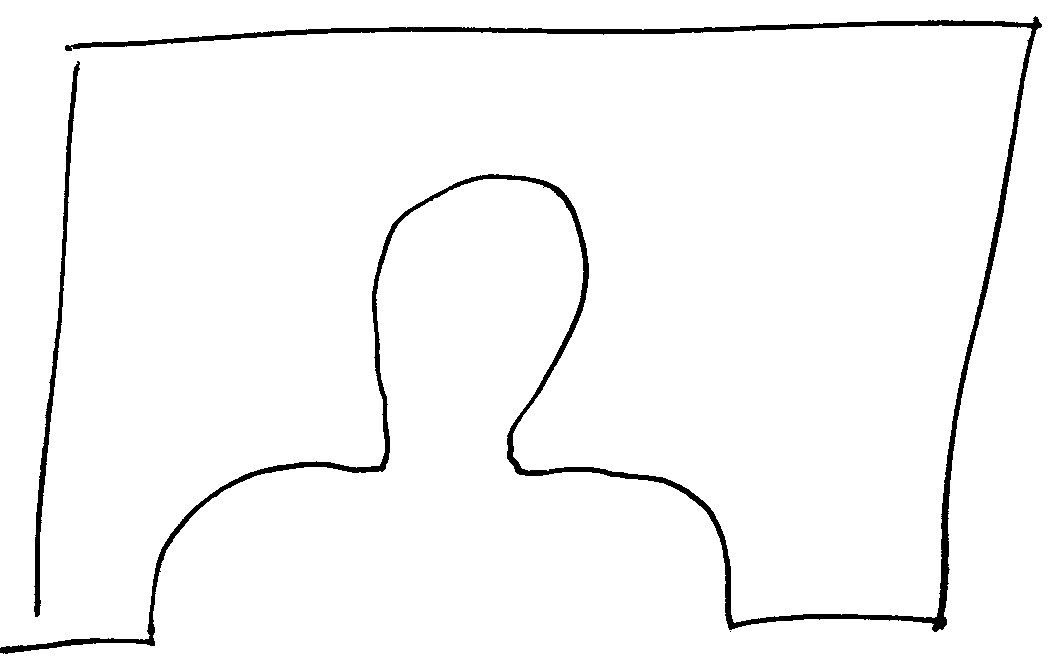
The drawing was made in the mid-90s, when I applied the principle of complementarity for the first time not only metaphorically but concretely material: In a piece with the title "Veronica" - which is an anagram to "vera icon": the true picture. In the piece, there are two different noise colors that are complementary to each other in the sense that they complement each other to white noise.
In another example, I would like to show that the transcendental principle of complementarity is also immanently effective, indeed almost displayable. I say "almost", because - and in this it is completely committed to the transcendental scheme - it can only be represented by being withdrawn.
The piece is called "Fallstudie" (which in german is both: "case study" and "fall study", a study about falling); It is a 1-person cinema for video and silence. I consider it one of my most unsuccessful pieces, as it is usually completely misunderstood. But since Gabriel used it for the program of the symposium, there seems to be at least one who might understand it.
[Fallstudie / short description]
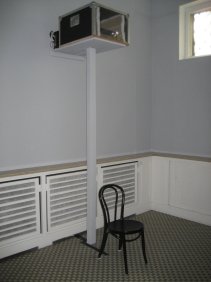
a small room / a projector / a chair / a movie on the wall / the room is not enough darkened to make a sharp image ...
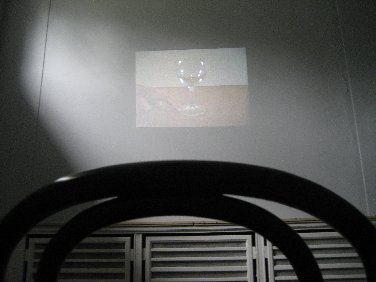
... the room is only ever entered by a single person at a time / movie is running already
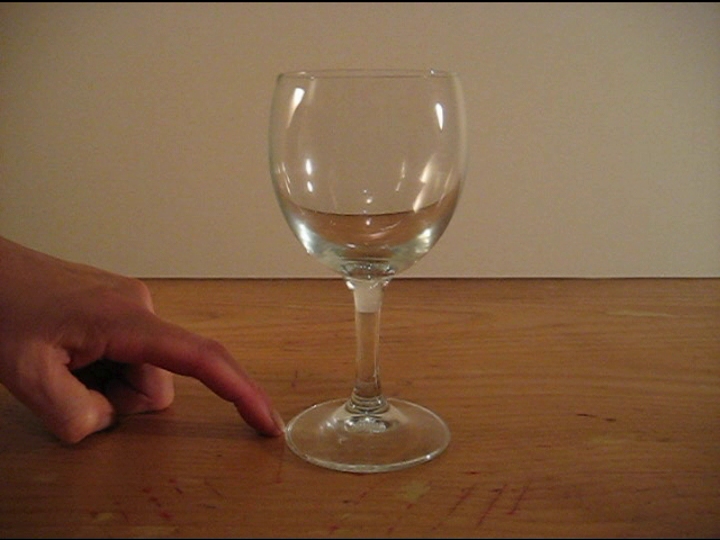
what can be seen is a glass beeing moved across the table - endlessly, as a loop - until you sit down: then the film jumps into the coda-mode ...
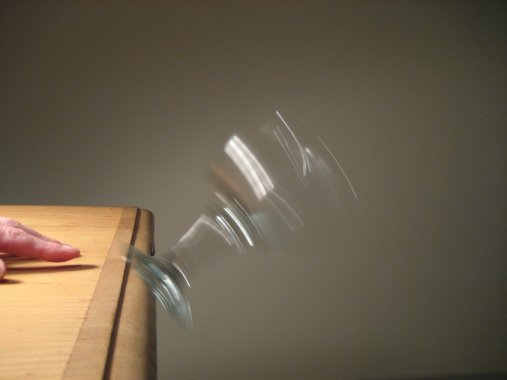
... the edge or the table comes into view. The end becomes foreseeable. But exactly in the moment when the glas is falling the projector turns off.
The image is projected directly onto the wall, so that no picture frame, no projection surface is left over when switching off. We (4) have taken great care that also the sound changes in the moment of quitting. The sound is nothing but the fan of the projector. And the fan of projectors usually go longer than until the turn-off of the picture. So we sealed off the real fan in a sound-absorbing box while we played back the sound of a false fan from a small speaker that such could actually end together with the picture.
Of course, everyone thinks, the piece is over when it's over. But the piece is made solely for the moment that follows its turning off. It's about the abrupt change of being thrown from fiction to the present. Before that I find myself in an unreal, and afterwards: alone in a room. I want you to fall out of the picture: into the now.
So that would be one of the most explicit demonstrations of the principle of complementarity, in which the artwork itself, the fabricated or made, is directed exclusively at what it itself is NOT.
If I may dwell for one more moment on the explication of my own working strategies I would like to point also to another aspect that is rarely considered. Namely on that what lies between two pieces.
Despite the practical diversity in my work of heterogeneous materials and settings, it is precisely in this diversity that I want to demonstrate how and that "one and the same" thing can be shown in two different ways.
The successful demonstration then still has a transcendental trait, which shows that "the thing", "the point" is not in the one nor in the other half but beyond both.
The "immanence" of complementarity is precisely the reason for the heterogeneity of the means I use, the reason for my many series. Heterogeneity is even a necessary prerequisite. I show something from one side, then from the other. But this is usually not working within a single piece. The two views are mutually exclusive, just as concert-like and installation-like situations can be mutually exclusive. A single piece is therefore necessarily incomplete. Nevertheless, I have tried again and again to grasp the transformation itself, the the moment of change, the transformation: as a cut - like in the "fall study" - as something that does not exist in time, as something that can be made tangible only through its juxtaposition, as a border.
The whole, totality, white noise can not be regarded as the whole, as totality, because totality always needs us to constitute it. And indeed we can never receive the whole as such, but only hints that what we are actually receiving, points to a 'more', or a more complete. And only from this hints we extrapolate the idea of the whole.
We hear white noise and can not hear it. What we do or can do is to filter extrapolations out of it. We hear something 'in' the noise. Often I had made the creation of illusions the subject of my work. But, strictly speaking, these are not just illusions. What we hear is actually there. Even if, as in prehistoric times, we recognize speech in the noise of a tree. And even if what we hear can not be confirmed by anyone else, or if everyone hears something different or nothing at all. What we hear is not yet an illusion because nobody else hears it. What we hear remains in the noise. The fact of not confirmed, unconfirmable hearing is precisely the indication that we are dealing here with a higher order, perhaps with a whole. Precisely through the lack of confirmation we are pushed to understand our filtered perception as filtered, and from there necessarily arises the idea of an unfiltered: the very whole. The real illusion is therefore not the reduced perception of a limited individual, but the conclusion onto the unreduced, the whole. But the conclusion is inevitable. Without the illusion of the non-reduced, the whole, totality, we would have no idea of the particularity, the reduced and the filtered, of our individual perception.
So it is exactly the loss, the lack of something, the unattainable, it is the incomplete that makes me complete in hearing.
And this for me is a true "transformation of the audible".
- 1) This Text originally was written for the closing talk at: "Transformations of the Audible", Symposium on Sound and Listening in the Arts, initiated and produced by Gabriel Paiuk, Den Haag, 16.-18.5.2019. (English translation un-edited).
2) Gabriel Paiuk, the producer of the symposium
3) from: "Metaphern (Wenn die Klänge die Klänge wären...)", in: Sabine Sanio, Christian Scheib (Hrsg.): "Übertragung - Transfer - Metapher", Kerber-Verlag, 2004; English translation: Meaghan Burke
4) Constructor of the installation: Winfried Ritsch
Vergleiche / Compare:
Veronica
Fallstudie
Rauschen
